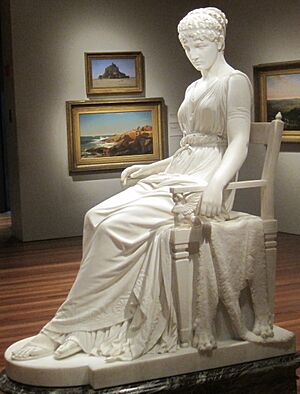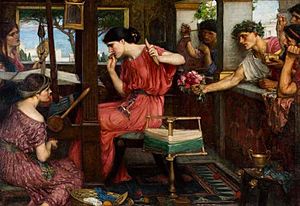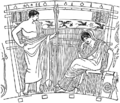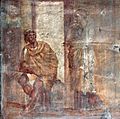Penelope facts for kids

Penelope (pronounced pə-NEL-ə-pee) is a famous character from Homer's ancient Greek story, the Odyssey. She was the queen of Ithaca. Her father was King Icarius of Sparta. Penelope is known for being a very loyal wife to her husband, Odysseus. She stayed true to him even though over a hundred men, called suitors, tried to marry her while Odysseus was away.
Penelope's Role in the Odyssey
Penelope is married to Odysseus, the king of Ithaca. They have one son named Telemachus. Telemachus was born just before Odysseus left to fight in the Trojan War. Penelope waited for twenty long years for Odysseus to come home. During this time, she used clever tricks to avoid marrying any of the 108 suitors.

When Odysseus finally returned, he was disguised as an old beggar. He found that Penelope had remained faithful to him. She had used smart ways to delay the suitors. One famous trick was pretending to weave a burial cloth for Odysseus's elderly father, Laertes. She told the suitors she would choose one of them when she finished the cloth. But every night for three years, she secretly undid part of her weaving. A slave named Melantho discovered her trick and told the suitors.
Penelope's efforts to avoid remarrying show her strong loyalty to Odysseus. This is why she is often seen as a symbol of a faithful wife.
When Odysseus, still in disguise, met Penelope, she announced a contest. She said she would marry whoever could string Odysseus's very stiff bow. Then, they had to shoot an arrow through twelve axe heads. This decision was a major turning point in the Odyssey. It made it possible for Odysseus to finally win against the suitors.
Some people wonder if Penelope knew it was Odysseus in disguise. She and the suitors knew that Odysseus was the only one who could truly use his bow. So, she might have started the contest to give him a chance to show who he was. Or, she might have just been trying to delay her marriage even longer.
When the bow contest began, none of the suitors could string the bow. Only Odysseus could do it, and he won the contest. Odysseus then revealed his true identity. Penelope, however, found it hard to believe it was really him. She worried it might be a god in disguise. To test him, she told her slave Eurycleia to move their special bed. Odysseus protested, explaining that he had built the bed himself. He knew one of its legs was a living olive tree, so it could not be moved.
This detail proved to Penelope that it was truly Odysseus. This moment showed their homophrosýnē, meaning they were "like-minded." Homer's story suggests that Odysseus and Penelope lived a long and happy life together after this. They ruled their kingdom wisely with their son, Telemachus.
How Penelope is Shown in Art
You can often recognize Penelope in ancient Greek and Roman artworks. These include paintings on vases and Roman sculptures. She is usually shown sitting down, with her cheek resting on her hand, looking thoughtful. Her knees are often crossed, which shows her long loyalty and purity while Odysseus was away. This pose is very unique to her.
Images for kids
-
Penelope encounters the returned Odysseus posing as a beggar. From a mural in the Macellum of Pompeii.
-
Penelope encounters the returned Odysseus posing as a beggar. From a mural in the Macellum of Pompeii.
-
Penelope, a bronze statue by Emile-Antoine Bourdelle.
-
Gold intaglio ring from Syria, late 5th century BC. It is now in the Louvre Museum.
See also
 In Spanish: Penélope para niños
In Spanish: Penélope para niños







